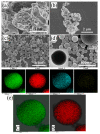A Novel One-Step Reactive Extrusion Process for High-Performance Rigid Crosslinked PVC Composite Fabrication Using Triazine Crosslinking Agent@Melamine-Formaldehyde Microcapsules
- PMID: 37444914
- PMCID: PMC10342326
- DOI: 10.3390/ma16134600
A Novel One-Step Reactive Extrusion Process for High-Performance Rigid Crosslinked PVC Composite Fabrication Using Triazine Crosslinking Agent@Melamine-Formaldehyde Microcapsules
Abstract
In this work, we propose, for the first time, a simple, fast, and efficient strategy to fabricate high-performance rigid crosslinked PVC composites by continuous extrusion. This strategy improves the poor processing fluidity of composites and solves the impossibility of conducting extrusion in one step via using microcapsule-type crosslinking agents prepared by in situ polymerization to co-extrude with PVC blends. The results demonstrate that the PVC/microcapsule composites were successfully prepared. Within the studied parameters, the properties of crosslinked PVC gradually increased with the addition of microcapsules, and its Vicat softening temperature increased from 79.3 °C to 86.2 °C compared with pure PVC. This study shows the possibility for the industrial scale-up of the extrusion process for rigid crosslinked PVC.
Keywords: crosslinking; extrusion; microcapsules; nanocomposites.
Conflict of interest statement
The authors declare no conflict of interest.
Figures








Similar articles
-
Self-Healing Poly(urea formaldehyde) Microcapsules: Synthesis and Characterization.Polymers (Basel). 2023 Mar 27;15(7):1668. doi: 10.3390/polym15071668. Polymers (Basel). 2023. PMID: 37050281 Free PMC article.
-
Towards the development of self-healing and antibacterial dental nanocomposites via incorporation of novel acrylic microcapsules.Dent Mater. 2022 May;38(5):858-873. doi: 10.1016/j.dental.2022.04.004. Epub 2022 Apr 14. Dent Mater. 2022. PMID: 35430108
-
Study of Melamine-Formaldehyde/Phase Change Material Microcapsules for the Preparation of Polymer Films by Extrusion.Membranes (Basel). 2022 Feb 25;12(3):266. doi: 10.3390/membranes12030266. Membranes (Basel). 2022. PMID: 35323742 Free PMC article.
-
Biodegradable Urea-Formaldehyde/PBS and Its Ternary Nanocomposite Prepared by a Novel and Scalable Reactive Extrusion Process for Slow-Release Applications in Agriculture.J Agric Food Chem. 2020 Apr 22;68(16):4595-4606. doi: 10.1021/acs.jafc.0c00638. Epub 2020 Apr 10. J Agric Food Chem. 2020. PMID: 32212653
-
A review and current state of autonomic self-healing microcapsules-based dental resin composites.Dent Mater. 2020 Mar;36(3):329-342. doi: 10.1016/j.dental.2019.12.005. Epub 2019 Dec 26. Dent Mater. 2020. PMID: 31883618
References
-
- Li Y.C., Lv L.D., Wang W.S., Zhang J.X., Lin J., Zhou J.Y., Dong M.Y., Gan Y.F., Seok I., Guo Z.H. Effects of chlorinated polyethylene and antimony trioxide on recycled polyvinyl chloride/acryl-butadiene-styrene blends: Flame retardancy and mechanical properties. Polymer. 2020;190:122198. doi: 10.1016/j.polymer.2020.122198. - DOI
-
- Klapiszewski L., Pawlak F., Tomaszewska J., Jesionowski T. Preparation and characterization of novel PVC/silica-lignin composites. Polymers. 2015;7:1767–1788. doi: 10.3390/polym7091482. - DOI
-
- Wang K.T., He Y., Song X.L., Cui X.M. Effects of the metakaolin-based geopolymer on high-temperature performances of geopolymer/PVC composite materials. Appl. Clay Sci. 2015;114:586–592. doi: 10.1016/j.clay.2015.07.008. - DOI
-
- Tillet G., Boutevin B., Ameduri B. Chemical reactions of polymer crosslinking and post-crosslinking at room and medium temperature. Prog. Polym. Sci. 2011;36:191–217. doi: 10.1016/j.progpolymsci.2010.08.003. - DOI
-
- Bednarek M., Borska K., Kubisa P. New polylactide-based materials by chemical crosslinking of PLA. Polym. Rev. 2020;61:493–519. doi: 10.1080/15583724.2020.1855194. - DOI
LinkOut - more resources
Full Text Sources

